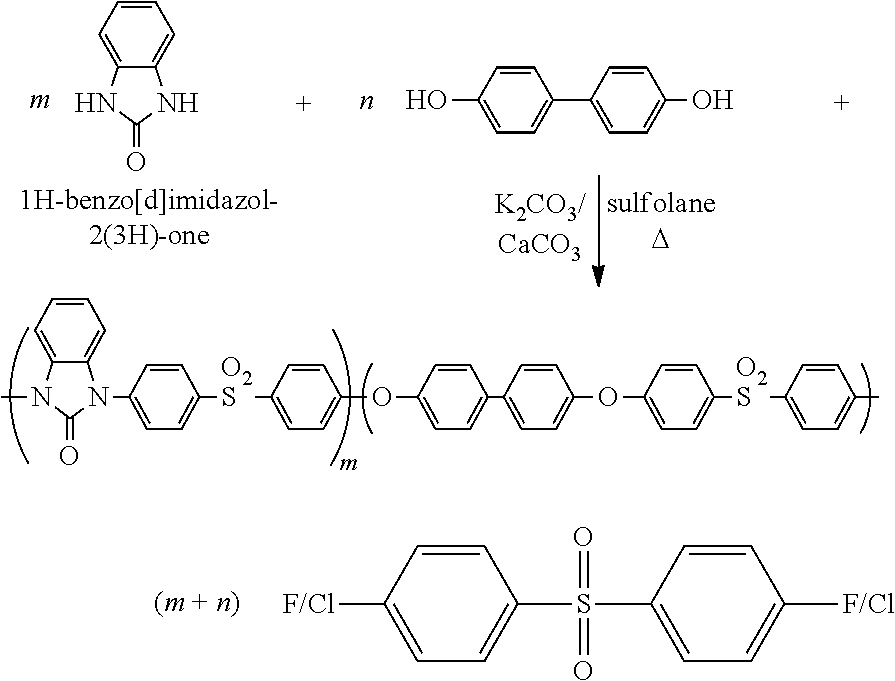Polymers and copolymers containing 2H-benzimidazol-2-one moieties
a technology of benzimidazol and 2hbenzimidazol, which is applied in the field of polymers and copolymers containing 2hbenzimidazol2one moieties, can solve the problems of low polymer yield, low tg, and inability to provide information on molecular weight, and achieve high tg and high thermal stability
- Summary
- Abstract
- Description
- Claims
- Application Information
AI Technical Summary
Benefits of technology
Problems solved by technology
Method used
Image
Examples
example 1
Polymerization of 2H-benzimidazol-2-one with bis(4-fluorophenyl)sulfone
Alternate names
[0050]1,3-dihydro-2H-benzimidazol-2-one[0051]2(1H)-Benzimidazol-2-one[0052]1H-benzo[d]imidazol-2(3H)-one
[0053]
[0054]The following procedure is typical for the preparation of homopolymer.
[0055]To a 25 mL three-necked round-bottom flask equipped with a Dean-Stark trap, a condenser, a magnetic stirrer, and an argon inlet were added 1H-benzo[d]imidazol-2(3H)-one (0.27 g, 2.0 mmol), bis(4-fluorophenyl)sulfone (0.51 g, 2.0 mmol), CaCO3 (0.20 g, 2.0 mmol), anhydrous K2CO3 (0.28 g, 2.0 mmol), sulfolane (1.4 g), and chlorobenzene (3 mL). The mixture was heated to azeotrope off the resulting water with chlorobenzene. The chlorobenzene was then removed, and the mixture was heated at 180-200° C. for 1-2 h. When the reaction system became too viscous to be stirred, an additional 2 g of sulfolane was added to dilute the solution, and it was kept at 200° C. for an additional 30 min until the viscosity significant...
examples 2-4
Copolymerization of 2H-benzimidazol-2-one with 4,4′-biphenol and bis(4-fluorophenyl)sulfone
[0057]
[0058]Example 4 is a typical procedure used for the copolymerization reactions.
[0059]To a 25 mL three-necked round-bottom flask equipped with a Dean-Stark trap, a condenser, a magnetic stirrer, and an argon inlet were added 4,4′-biphenol (0.26 g, 1.4 mmol), benzimidazol-2-one (0.080 g, 0.60 mmol), bis(4-fluorophenyl)sulfone (0.51 g, 2.0 mmol), CaCO3 (0.20 g, 2.0 mmol), anhydrous K2CO3 (0.28 g, 2.0 mmol), sulfolane (1.6 g), and chlorobenzene (3 mL). The mixture was heated to azeotrope off the resulting water with chlorobenzene. The chlorobenzene was then removed, and the mixture was heated at 180-200° C. for 1-2 h. When the reaction system became too viscous to be stirred, an additional 2 g of sulfolane was added to dilute the solution, and the mixture was kept at 200° C. for an additional 30 min until the viscosity significantly increased. The reaction mixture was cooled down, and dilute...
examples 5-7
Copolymerization of benzimidazol-2-one with bisphenol A (BPA) and bis(4-fluorophenyl)sulfone
[0062]
[0063]Example 5 is a typical procedure used for the copolymerization reactions.
[0064]To a 25 mL three-necked round-bottom flask equipped with a Dean-Stark trap, a condenser, a magnetic stirrer, and an argon inlet were added BPA (0.14 g, 0.60 mmol), benzimidazol-2-one (0.19 g, 1.4 mmol), bis(4-fluorophenyl)sulfone (0.51 g, 2.0 mmol), CaCO3 (0.20 g, 2.0 mmol), anhydrous K2CO3 (0.28 g, 2.0 mmol), sulfolane (1.6 g), and chlorobenzene (3 mL). The reaction mixture was heated to azeotrope off the resulting water with chlorobenzene. The chlorobenzene was then removed, and the resulting mixture was heated at 180-200° C. for 1-2 h. When the reaction system became too viscous to be stirred, an additional 2 g of sulfolane was added to dilute the solution, and the mixture was kept at 200° C. for an additional 30 min until the viscosity significantly increased. The reaction mixture was cooled down an...
PUM
| Property | Measurement | Unit |
|---|---|---|
| temperature | aaaaa | aaaaa |
| Tg | aaaaa | aaaaa |
| melt temperature | aaaaa | aaaaa |
Abstract
Description
Claims
Application Information
 Login to View More
Login to View More - R&D
- Intellectual Property
- Life Sciences
- Materials
- Tech Scout
- Unparalleled Data Quality
- Higher Quality Content
- 60% Fewer Hallucinations
Browse by: Latest US Patents, China's latest patents, Technical Efficacy Thesaurus, Application Domain, Technology Topic, Popular Technical Reports.
© 2025 PatSnap. All rights reserved.Legal|Privacy policy|Modern Slavery Act Transparency Statement|Sitemap|About US| Contact US: help@patsnap.com



